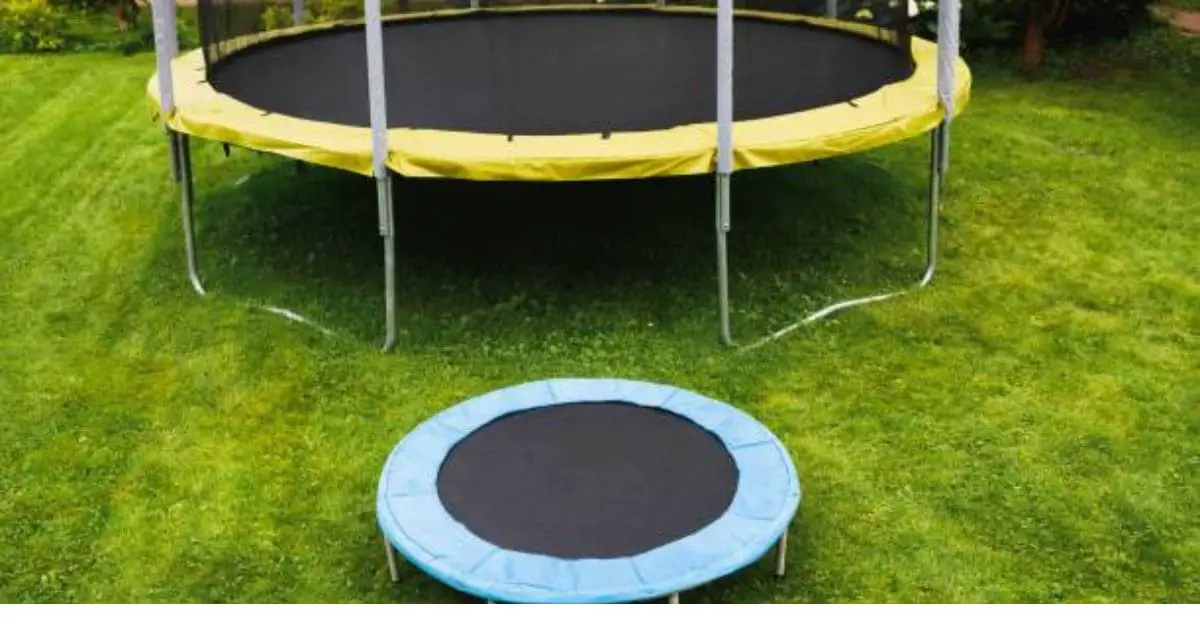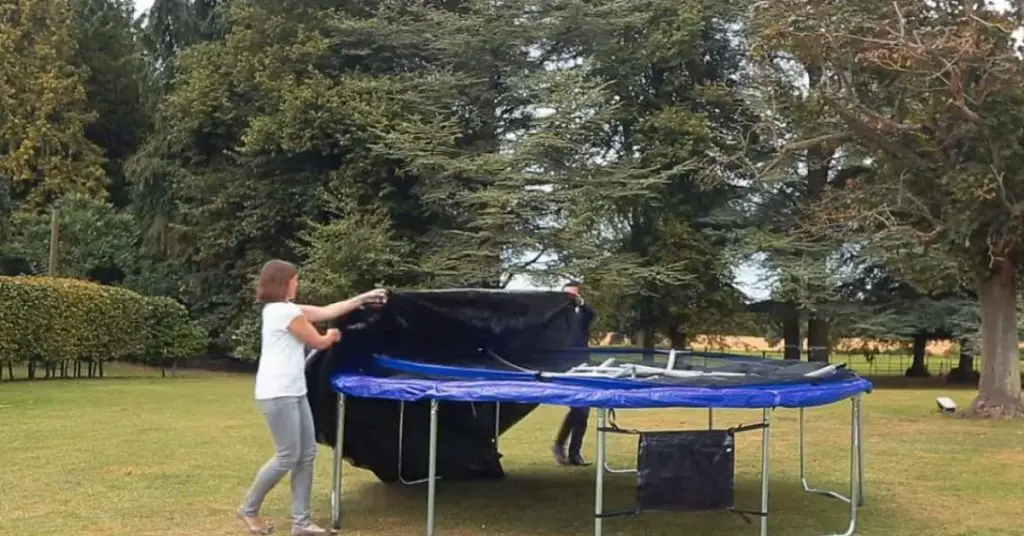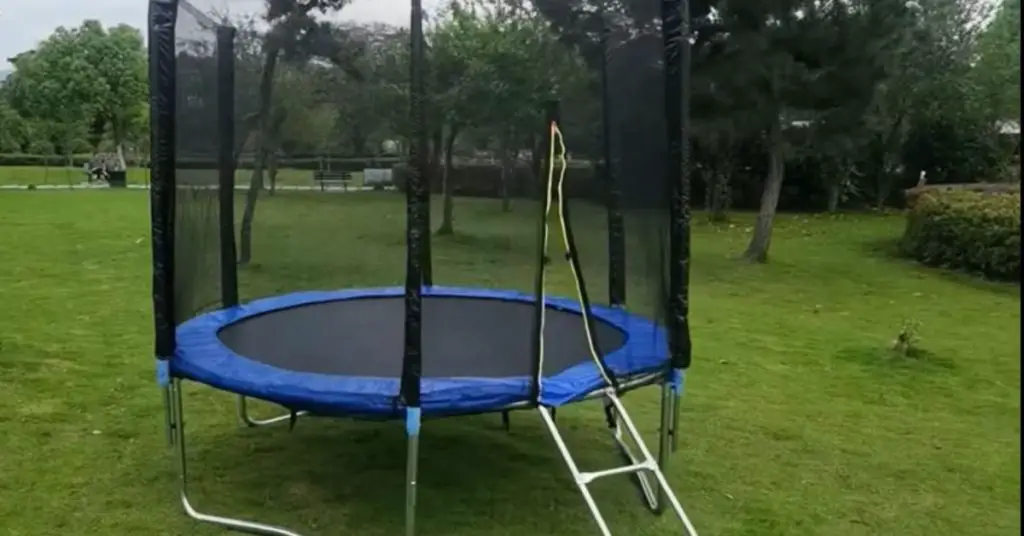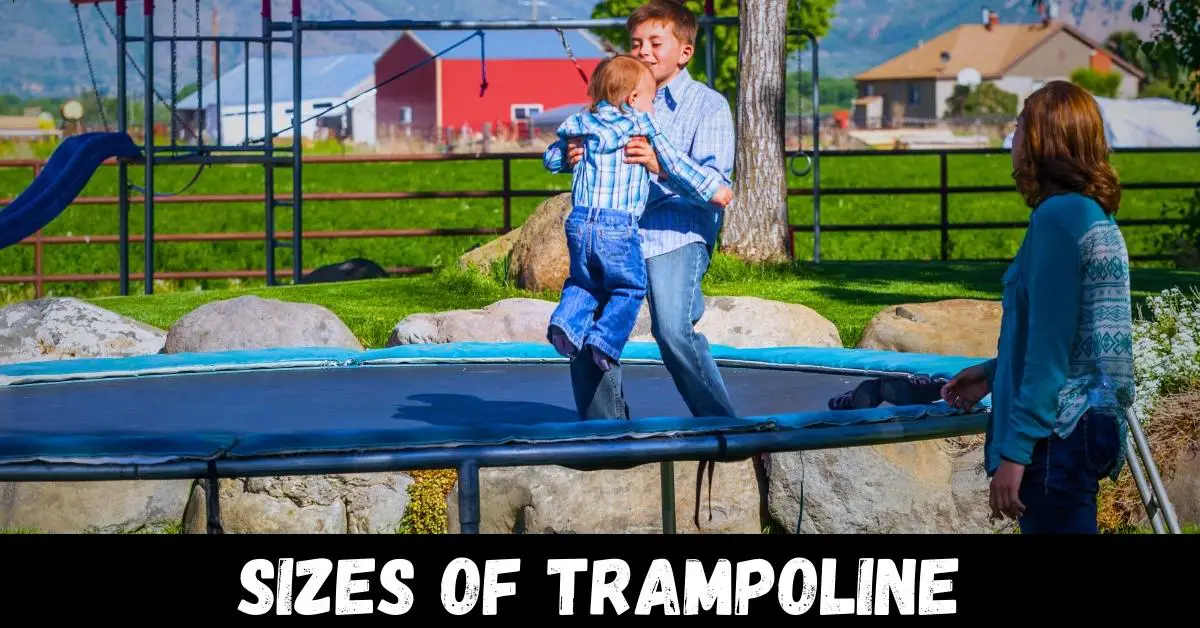Trampolines offer a thrilling and engaging way to enjoy outdoor recreation and exercise. With their popularity on the rise, trampolines come in various sizes to accommodate different needs and spaces.
The size of a trampoline plays a crucial role in determining the jumping area, user capacity, and overall experience.
From compact mini trampolines to larger models suitable for families and even professional athletes, the range of trampoline sizes available in the market caters to diverse requirements.
Trampolines can be found in different shapes, including round, rectangular, square, and octagonal, each offering unique advantages and suitability for specific purposes.
Selecting the right trampoline size involves considering factors such as available space, intended users, age groups, and the desired activities to be performed.
Understanding the various trampoline sizes and their implications is essential for making an informed decision and ensuring a safe and enjoyable trampoline experience for individuals of all ages.
In this article, we will explore the different sizes of trampolines, delve into their features and suitability for various user groups, and provide insights to help you choose the perfect trampoline size for your needs.
Sizes of trampoline: Trampolines come in a range of sizes to accommodate different needs and spaces. From compact mini trampolines to larger models for families and athletes, selecting the right size is crucial for a safe and enjoyable trampolining experience.
Sizes of Trampoline?

Trampolines come in different sizes to suit various needs and spaces. They range from small trampolines, around 6-8 ft in diameter, to medium-sized trampolines, typically 10-12 ft in diameter, and large trampolines, which can be 14-16 ft in diameter or even bigger.
It’s important to choose a trampoline size that fits your available space and intended use for a safe and enjoyable experience.
Understanding Trampoline Measurements
Trampolines are a popular recreational device that provides hours of fun and entertainment for people of all ages. Whether you’re a child bouncing with glee or an adult enjoying a workout, trampolines offer a unique way to stay active and engaged.
When it comes to purchasing a trampoline, understanding the various measurements is crucial. This article will explore how trampolines are measured, the different size categories, common shapes, and the significance of weight limits and height.
How Trampolines are Measured?
Trampolines are typically measured by their diameter, which refers to the distance across the widest point of the jumping surface. The most common measurement for trampolines is in feet, with sizes ranging from 6 feet to over 17 feet in diameter.
Smaller trampolines are suitable for younger children or individuals with limited space, while larger trampolines are ideal for families or those looking for a more spacious jumping area.
In addition to the diameter, trampolines are also measured by their frame size, which includes the outer edge of the frame. This measurement is important when considering the space needed for installation and ensuring the trampoline fits within your designated area.
Different Trampoline Size Categories:
Trampolines can be categorized into various size categories, each serving different purposes and user needs. Let’s explore some of the most common categories:
Standard Size: Standard trampolines typically range from 8 to 14 feet in diameter. They are suitable for recreational use in backyards and are popular among families with children. These trampolines offer a good balance between size and affordability.
Average Size: Average-sized trampolines fall within the range of 10 to 12 feet in diameter. They are often chosen by individuals or families who have limited space but still want to enjoy the benefits of a trampoline.
These trampolines provide a decent jumping area while being easier to fit in smaller yards.
Olympic Size: Olympic-sized trampolines are designed for competitive use and follow specific regulations set by international sports organizations.
These trampolines have a diameter of 17 feet and are used by professional athletes in trampoline gymnastics. They offer a larger jumping area and are built to withstand high-impact movements.
Common Shapes of Trampolines:
Trampolines come in various shapes, with the most popular ones being round, rectangular, square, and octagonal. Each shape has its advantages and considerations:
Round: Round trampolines are the most common and widely available. They offer a consistent bounce across the entire surface and are often recommended for recreational use.
The circular design naturally directs jumpers toward the center, making it a safer option for beginners and children.
Rectangular: Rectangular trampolines are often favored by professional athletes and gymnasts. They provide a powerful and controlled bounce, allowing for higher jumps and more complex movements.
The even tension of the springs throughout the frame provides a consistent rebound across the entire surface, making it ideal for advanced users.
Square: Square trampolines combine the benefits of round and rectangular trampolines. They offer a larger jumping area than round trampolines, while still providing a controlled bounce similar to rectangular ones.
Square trampolines are a popular choice for families and individuals looking for a versatile option.
Octagonal: Octagonal trampolines are a less common but unique option. They provide a more spacious jumping area than round trampolines and offer a good compromise between round and rectangular designs.
Octagonal trampolines can be an excellent choice for users who want a larger surface without compromising on bounce quality.
Explaining Weight Limits and Height of Trampolines:
Trampolines come with weight limits that indicate the maximum load they can safely support. The weight limit includes the combined weight of all jumpers, taking into account the stress applied to the springs, frame, and mat.
It is crucial to adhere to the weight limit to prevent damage to the trampoline and ensure the safety of the users. Exceeding the weight limit can lead to a compromised bouncing experience and an increased risk of accidents.
The height of a trampoline refers to the distance from the ground to the top of the jumping surface. Trampolines vary in height, with some models designed to be closer to the ground for easier access, especially for younger children or individuals with mobility issues.
Higher trampolines are often preferred by experienced jumpers or athletes who require more vertical clearance for advanced maneuvers.
It’s important to note that regardless of the height of the trampoline, safety precautions such as enclosures and padding should be in place to prevent injuries from falls.
Determining the Right Trampoline Size
When it comes to purchasing a trampoline, selecting the right size is crucial for a safe and enjoyable bouncing experience. The size of the trampoline depends on individual needs, preferences, and the intended users.
we will discuss how to determine the right trampoline size by assessing individual needs, pre-considering factors for sizing, and recommending sizes for different user groups based on age.
Assessing Individual Needs and Preferences:
Before choosing a trampoline size, it’s important to assess individual needs and preferences. Consider the following factors:
Available Space: Evaluate the area where you plan to install the trampoline. Measure the dimensions and take note of any obstacles or limitations, such as trees, fences, or structures. This will help you determine the maximum size that can comfortably fit within the designated space.
Intended Use: Determine the purpose of the trampoline. Are you looking for a recreational trampoline for the family or a professional-grade trampoline for gymnastic training?
Different uses may require varying sizes to accommodate specific activities and user requirements.
Number of Users: Consider the number of individuals who will be using the trampoline simultaneously. If multiple people will be jumping together, it’s important to select a size that provides enough space for everyone to bounce comfortably without overcrowding.
Pre-Considering Factors for Trampoline Sizing:
In addition to individual needs, there are several factors to consider when determining the right trampoline size:
Safety Clearance: Ensure that there is sufficient clearance around the trampoline to prevent accidents. Leave at least a 2-meter (6.5 feet) buffer zone on all sides to avoid collisions with walls, fences, or other objects.
Weight Limit: Take into account the weight limit of the trampoline to ensure it can safely support the intended users. Consider the combined weight of all individuals who will be jumping on the trampoline simultaneously.
Skill Level: Consider the skill level of the users. Advanced jumpers or athletes may require larger trampolines to perform complex maneuvers, while beginners or younger children can generally make do with smaller sizes.
Age-Wise Average Trampoline Sizes:
Here are some age-wise average trampoline sizes that can serve as a general guideline:
Kids Under 5: For younger children, trampolines with a diameter of 6 to 8 feet are typically suitable. These smaller sizes provide a safe and controlled jumping area, allowing young children to enjoy bouncing while minimizing the risk of accidents.
Kids Over 6: For older children, a trampoline with a diameter of 10 to 12 feet is recommended. This size offers more space for energetic play and allows for more freedom of movement during jumps.
13-Year-Olds and Younger: Trampolines ranging from 12 to 14 feet in diameter are suitable for teenagers and younger individuals. These sizes provide a generous jumping area, accommodating the energy and enthusiasm of active youngsters.
Recommended Trampoline Sizes for Different User Groups:
Apart from age, the following recommendations can help determine the appropriate trampoline size for different user groups:
Gymnasts or Athletes: If you’re a gymnast or athlete looking to use a trampoline for training purposes, consider rectangular trampolines. These trampolines offer a larger jumping surface and superior bounce quality.
Sizes typically range from 10 by 17 feet to 14 by 16 feet, providing ample room for performing complex routines and maneuvers.
Recreational Family Use: For families looking for a trampoline that can accommodate multiple users, a round trampoline with a diameter of 14 to 16 feet is a popular choice. This site offers sufficient space for children and adults to jump together comfortably.
Backyard Entertainment: If you have a spacious backyard and enjoy hosting gatherings or parties, consider larger trampolines with a diameter of 16 to 17 feet.
These sizes can accommodate multiple jumpers simultaneously, providing a fun and engaging experience for guests.
Remember that these recommendations are general guidelines, and individual preferences and needs may vary. It’s always best to consider the specific requirements and circumstances of your situation before making a final decision on the trampoline size.
Evaluating Available Trampoline Sizes

When choosing a trampoline, it’s important to evaluate the available sizes to find the one that best suits your needs and preferences.
Different sizes offer varying levels of jumping space, weight capacities, and suitability for different activities.
we will discuss standard trampoline sizes, compare round, rectangular, and square trampolines in different sizes, review the pros and cons of different sizes, and explore notable brands and their available trampoline sizes such as Skywalker, AlleyOop, JumpSport, Pure Fun, and Ultega Jumper.
Standard Trampoline Sizes and Their Suitability:
Trampolines come in various sizes, and understanding the standard sizes can help you make an informed decision. The most common standard trampoline sizes include:
8 feet: Trampolines with an 8-foot diameter are compact and suitable for smaller spaces. They are ideal for younger children or individuals with limited yard space.
10 feet: Trampolines with a 10-foot diameter offer a good balance between size and affordability. They are suitable for recreational use and can accommodate children and adults alike.
12 feet: Trampolines with a 12-foot diameter provide a larger jumping area, making them popular among families. They offer ample space for energetic play and can accommodate multiple jumpers.
14 feet: Trampolines with a 14-foot diameter are even larger and provide more room for jumping and performing tricks. They are suitable for active families or individuals looking for a spacious bouncing surface.
Comparison of Round, Rectangular, and Square Trampolines in Different Sizes:
Round, rectangular, and square trampolines are the most common shapes available. Let’s compare them in different sizes to understand their characteristics and suitability:
Round Trampolines: Round trampolines are the most popular and widely available. They offer a consistent bounce across the entire surface and are generally considered safer due to their design directing jumpers toward the center.
Round trampolines are available in various sizes, from small 8-foot models to larger 16-foot ones. They are suitable for recreational use and cater to a wide range of users.
Rectangular Trampolines: Rectangular trampolines are often favored by gymnasts and athletes. They provide a more controlled bounce and higher jumps due to the even tension of the springs throughout the frame.
Rectangular trampolines are available in sizes ranging from 7 by 10 feet to 10 by 17 feet. They are ideal for individuals interested in advanced tricks, tumbling, or gymnastic training.
Square Trampolines: Square trampolines combine some benefits of round and rectangular trampolines. They offer a larger jumping area than round trampolines while maintaining a controlled bounce similar to rectangular ones.
Square trampolines are available in sizes ranging from 8 to 15 feet and are suitable for families or individuals seeking versatility in their bouncing experience.
Notable Brands and Their Available Trampoline Sizes:
Several brands offer quality trampolines in various sizes. Here are some notable brands and their available trampoline sizes:
Skywalker: Skywalker trampolines are known for their durability and safety features. They offer a wide range of sizes, including 8, 10, 12, 14, and 15 feet, catering to different needs and budgets.
AlleyOop: AlleyOop trampolines are renowned for their innovative design and superior bounce quality. They offer sizes ranging from 10 to 14 feet, with their DoubleBounce models providing an added layer of safety and performance.
JumpSport: JumpSport is known for producing high-quality trampolines with excellent safety features. They offer a range of sizes, including 8, 10, 12, and 14 feet, suitable for various users and purposes.
Pure Fun: Pure Fun trampolines are designed for recreational use and offer affordable options. They provide sizes such as 8, 12, and 14 feet, catering to different preferences and space limitations.
Ultega Jumper: Ultega Jumper trampolines are known for their sturdy construction and user-friendly design. They offer sizes ranging from 10 to 14 feet, suitable for recreational use and family enjoyment.
When choosing a trampoline, consider reputable brands that prioritize safety, quality, and customer satisfaction. Explore their product lines to find the right size and features that align with your requirements.
Assessing Space Requirements for Trampolines

When considering purchasing a trampoline, it’s crucial to assess the space available to ensure a safe and enjoyable bouncing experience.
The amount of room needed for a trampoline depends on various factors, including the trampoline’s shape, size, and whether it will be placed indoors or outdoors.
we will discuss how much room is needed for a trampoline, measuring considerations for different trampoline shapes (round, rectangular, square, and octagonal), and the space requirements for outdoor and indoor trampolines.
How Much Room is Needed for a Trampoline?
The amount of space required for a trampoline is determined by several factors to ensure safety and adequate clearance. Here are some general guidelines:
Horizontal Clearance: A buffer zone around the trampoline is essential to prevent collisions with walls, fences, trees, or other objects.
It is recommended to leave a minimum clearance of 2 meters (6.5 feet) on all sides of the trampoline. This space allows for safe entry and exit from the trampoline and reduces the risk of accidents.
Vertical Clearance: Adequate vertical clearance is crucial to prevent jumpers from hitting overhead obstacles such as tree branches, power lines, or structures.
Ensure that there are no obstructions above the trampoline and provide a clear vertical space of at least 5 meters (16.5 feet).
Surface: The trampoline should be placed on a flat, level surface. Avoid slopes, uneven ground, or areas with debris. A solid and stable surface, such as grass or a specialized trampoline safety mat, is recommended to minimize the risk of accidents.
Measuring Considerations for Different Trampoline Shapes:
Trampolines come in various shapes, including round, rectangular, square, and octagonal. Here are some measuring considerations for each shape:
Round Trampolines: When measuring a round trampoline, measure the diameter, which is the distance across the trampoline through its center.
Take this measurement into account when assessing the available space, ensuring the buffer zone of 2 meters (6.5 feet) is maintained on all sides.
Rectangular Trampolines: For rectangular trampolines, measure the length and width of the trampoline. These measurements determine the dimensions of the rectangular frame.
Consider the maximum dimensions of the trampoline, including the length of the longest jump and the width required for safe movement and clearance.
Square Trampolines: Similar to rectangular trampolines, square trampolines require measurements for both length and width.
Ensure that the available space can accommodate the square frame, maintaining the necessary buffer zone and allowing for safe movement around the trampoline.
Octagonal Trampolines: Octagonal trampolines have eight sides, making them slightly more complex to measure. Measure the distance across the widest points of the octagon to determine the size of the trampoline.
Ensure sufficient clearance is maintained on all sides, similar to other trampoline shapes.
Outdoor vs. Indoor Trampoline Space Requirements:
The space requirements for outdoor and indoor trampolines can differ due to different considerations. Here’s what to keep in mind for each:
Outdoor Trampolines: Outdoor trampolines typically require more space due to the availability of larger yards. When placing a trampoline outdoors, ensure that there is ample room for the trampoline size, as well as the necessary buffer zone on all sides.
Take into account any permanent structures, trees, or fencing that may affect the available space.
Indoor Trampolines: Indoor trampolines are designed for use in enclosed spaces such as gyms, fitness centers, or dedicated indoor trampoline parks. The space requirements for indoor trampolines are determined by the facility’s layout and regulations.
When considering an indoor trampoline, consult the specific guidelines provided by the facility to ensure compliance with safety standards and the required space for installation.
In both cases, it’s important to consider the height of the space as well. Ensure there is sufficient vertical clearance, free from any overhead obstructions, to allow for safe jumping and movement on the trampoline.
Factors Influencing Trampoline Prices
Trampolines come in a wide range of prices, and understanding the factors that influence these prices can help you make an informed purchasing decision.
Several key factors, such as size, quality, and design, play a significant role in determining the cost of a trampoline.
we will explore the correlation between trampoline size, quality, and price, examine the price range for different trampoline sizes, and discuss the impact of springless and spring trampolines on pricing.
Understanding the Correlation between Size, Quality, and Price:
Size:
Trampoline size is one of the primary factors influencing the price. Generally, larger trampolines cost more than smaller ones due to the increased materials and manufacturing involved.
Larger trampolines provide more jumping space, accommodating multiple users and allowing for more freedom of movement.
However, it’s important to note that size alone is not the sole indicator of quality, and other factors such as frame construction, jumping mat material, and safety features should also be considered.
Quality:
The quality of materials and construction significantly affects the price of a trampoline. High-quality trampolines are built to withstand regular use, resist weather elements, and maintain their structural integrity over time.
They often feature robust frames made from durable materials, sturdy springs or alternative bounce systems, and UV-resistant jumping mats.
Higher-quality trampolines are designed with safety in mind, incorporating features such as reinforced netting, padded safety enclosures, and quality springs or bounce mechanisms.
Design and Features:
Trampolines with additional design elements and features tend to be priced higher. These features can include advanced safety enclosures, built-in ladder systems, anchor kits, basketball hoops, or specialized bounce systems for enhanced performance.
While these features can enhance the trampoline experience, they also contribute to the overall cost.
Exploring the Price Range for Different Trampoline Sizes:

Trampoline prices can vary significantly based on their size. Here is a general price range for different trampoline sizes:
Small Trampolines (8-10 feet): Small trampolines designed for younger children or limited spaces typically range from $150 to $500.
The price variation depends on factors such as brand reputation, quality of materials, safety features, and additional accessories.
Medium Trampolines (12-14 feet): Medium-sized trampolines suitable for families and recreational use generally range from $300 to $800. The price range can be influenced by factors such as brand reputation, frame quality, bounce system, safety features, and additional accessories.
Large Trampolines (16-17 feet): Large trampolines that provide ample jumping space and accommodate multiple users usually range from $700 to $2,000 or more.
The higher end of the price range typically includes premium features, exceptional durability, advanced safety measures, and enhanced bounce systems.
Springless vs. Spring Trampolines and Their Impact on Pricing:
Another factor that influences trampoline pricing is the choice between springless and spring trampolines. Here’s an overview of their impact on pricing:
Springless Trampolines:
Springless trampolines use alternative bounce systems such as elastic bands or fiberglass rods instead of traditional metal springs. These systems often provide a gentler and more controlled bounce, reducing the risk of accidental injuries.
Springless trampolines are typically priced higher than their spring counterparts due to the advanced technology involved, increased manufacturing costs, and the added safety benefits they offer.
Spring Trampolines:
Spring trampolines are the traditional trampolines that use metal springs to create the bounce. They are generally more affordable compared to springless trampolines.
The price can vary based on factors such as the number and quality of springs, frame construction, jumping mat material, safety features, and brand reputation.
It’s important to note that while springless trampolines may have a higher upfront cost, they often provide a longer lifespan and require less maintenance than spring trampolines.
Additionally, the safety benefits they offer can outweigh the initial price difference for many buyers.
Choosing the Perfect Trampoline Size
When it comes to choosing a trampoline, finding the perfect size is crucial to ensure a safe and enjoyable bouncing experience.
Trampolines come in various sizes, and selecting the right one depends on factors such as the number of users, available space, and specific user scenarios.
we will address common trampoline size-related questions, explore the most common trampoline sizes, consider variations of mini trampolines and their sizes, and provide recommended trampoline sizes for specific user scenarios.
How do I determine the right trampoline size for my needs?
To determine the appropriate trampoline size, consider factors such as the available space in your yard or indoor area, the number of users, and their age and skill level.
It’s essential to leave a buffer zone around the trampoline for safety, ensuring there is sufficient clearance on all sides.
What if I have limited space?
If you have limited space, consider smaller trampoline sizes or compact options such as mini trampolines or foldable trampolines. These can provide a suitable bouncing experience while minimizing the footprint.
Can I have a larger trampoline if my space allows it?
If you have ample space, opting for a larger trampoline can provide more jumping surfaces and accommodate multiple users simultaneously.
However, it’s important to ensure that the available space can accommodate the larger size while maintaining the necessary clearance around the trampoline.
Exploring the Most Common Trampoline Sizes:
Trampolines come in various sizes to suit different user needs. Here are some of the most common trampoline sizes:
Small Trampolines (8-10 feet): Small trampolines are ideal for young children or those with limited yard space. They provide a safe and controlled bouncing experience and are often more affordable. These sizes can accommodate one or two children at a time.
Medium Trampolines (12-14 feet): Medium-sized trampolines are suitable for families or individuals who want a balance between space and budget. They provide enough room for a few users and allow for more freedom of movement during bouncing sessions.
Large Trampolines (16-17 feet): Large trampolines are perfect for families, multiple users, or those who want a spacious jumping surface for recreational activities or advanced tricks.
These sizes can accommodate several users simultaneously and provide an exhilarating bouncing experience.
Considering Variations of Mini Trampolines and Their Sizes:
Mini trampolines, also known as rebounders, are smaller versions of traditional trampolines. They are designed for individual use and are often used for fitness and cardio exercises.
Mini trampolines typically come in sizes ranging from 36 inches to 48 inches in diameter.
They are compact, lightweight, and can be used both indoors and outdoors. When choosing a mini trampoline, consider the available space, your fitness goals, and the weight capacity to ensure a suitable size for your needs.
Recommended Trampoline Sizes for Specific User Scenarios:
Multiple Children: If you have multiple children who will be using the trampoline simultaneously, a medium-sized trampoline in the range of 12 to 14 feet is recommended. This size provides enough space for them to jump together safely.
Whole Family: For families who plan to use the trampoline together, a large trampoline in the range of 16 to 17 feet is recommended. This size can accommodate adults and children alike and allows for group activities and shared bouncing experiences.
Gymnastics: If you or your child is involved in gymnastics or advanced tricks, a larger trampoline with a rectangular shape is often preferred.
Rectangular trampolines provide a consistent bounce across the entire surface and offer more control for precise movements. Sizes in the range of 14 to 17 feet are suitable for gymnastics purposes.
Rectangle trampoline sizes
Rectangular trampolines come in various sizes to cater to different needs and available spaces. Here are some common rectangular trampoline sizes:
8 ft x 12 ft: This size is suitable for smaller yards or spaces. It provides a decent jumping area while still being compact.
10 ft x 14 ft: This size offers a slightly larger jumping surface than the 8 ft x 12 ft option. It is ideal for individuals or families who have a moderate-sized yard.
14 ft x 16 ft: This site provides a generous jumping area and is well-suited for those with larger yards or more advanced jumpers who require extra space for tricks and flips.
15 ft x 17 ft: This is one of the largest rectangular trampoline sizes available. It offers an expansive jumping surface and is suitable for individuals or families with ample outdoor space.
What size trampoline for adults
When choosing a trampoline size for adults, it’s important to consider both the available space and the intended use of the trampoline. Generally, larger trampoline sizes are recommended for adults as they provide more room for jumping and movement.
For individual use or recreational bouncing, a trampoline size of 12 feet or larger is often suitable for adults. This size allows for comfortable jumping and performing various exercises or tricks.
If multiple adults will be using the trampoline simultaneously, it’s advisable to opt for a larger size to accommodate their movements. A trampoline size of 14 feet or larger would be more appropriate in this case.
How to measure trampoline size

To measure the size of a trampoline, follow these steps:
Determine the Shape: Identify whether the trampoline is round, rectangular, square, or another shape. This will affect how you measure its size.
Measure the Diameter (Round Trampolines): For round trampolines, measure the distance across the trampoline from one edge, passing through the center, to the opposite edge. This measurement will give you the diameter of the trampoline.
Measure the Length and Width (Rectangular or Square Trampolines): For rectangular or square trampolines, measure the length from one end to the other and the width from side to side. Take these measurements at the widest points of the trampoline.
Note the Dimensions: Once you have measured the diameter or length and width, make a note of the measurements. For example, a trampoline might be 14 feet in diameter or 10 feet long and 8 feet wide.
Consider the Jumping Surface: Keep in mind that the actual jumping surface may be slightly smaller than the overall dimensions. The jumping surface is typically a bit smaller to account for the frame and padding.
Dimensions of 14 ft trampoline
A 14 ft trampoline typically refers to the diameter of the trampoline. The diameter represents the distance across the trampoline from one edge to the opposite edge, passing through the center.
For a 14 ft trampoline, the diameter would be 14 feet. However, it’s important to note that the actual dimensions of a trampoline can vary slightly depending on the manufacturer and specific model.
In terms of the jumping surface, which is the usable area for bouncing, the dimensions of a 14 ft trampoline would be slightly smaller. This is because the frame and padding around the trampoline reduce the space for jumping.
It’s always recommended to check the specifications provided by the manufacturer when purchasing a trampoline to get the exact dimensions and ensure it fits your available space.
What size trampoline for 2 kids?
The size of a trampoline for two kids depends on their age, size, and the level of activity they will engage in. Here are some general recommendations:
For younger children (ages 3-6): A trampoline size of 8 to 10 feet in diameter is typically suitable. This size provides enough space for two kids to jump comfortably and safely.
For older children (ages 7-12): A trampoline size of 10 to 12 feet in diameter is generally recommended. This larger size allows for more room to jump, and perform tricks, and accommodates the growing size and energy of older kids.
Consider the weight limit: Make sure to check the weight limit of the trampoline you are considering. It should be able to accommodate the combined weight of both children.
Consider the activity level: If the kids are more active and involved in gymnastics or acrobatics, a larger trampoline in the range of 12 to 14 feet may provide them with the space they need to practice their skills.
What size trampoline for 3 kids?
When considering a trampoline size for three kids, it’s important to take into account their age, size, and the level of activity they will engage in. Here are some general recommendations:
For younger children (ages 3-6): A trampoline size of 10 to 12 feet in diameter is typically suitable for three younger children. This size provides enough space for them to jump, play, and have fun together.
For older children (ages 7-12): A trampoline size of 12 to 14 feet in diameter is generally recommended. This larger size allows for more room to accommodate the larger size and energy of older kids and provides enough space for them to jump, do tricks, and play together.
Consider the weight limit: Check the weight limit of the trampoline you are considering. It should be able to support the combined weight of all three children.
Consider the activity level: If the kids are more active and interested in gymnastics or advanced tricks, you might want to consider a larger trampoline size, such as 14 to 16 feet in diameter, to provide them with sufficient space for their movements.
12-foot trampoline

A 12-foot trampoline typically has a diameter of 12 feet, providing a suitable size for adults to enjoy bouncing and various activities.
This size offers enough space for an individual or a couple of adults to comfortably jump, exercise, and have fun.
A 12-foot trampoline is versatile and can accommodate activities such as basic jumping, light exercises, and even simple tricks.
It strikes a good balance between size and space requirements, making it a popular choice for those with moderate-sized yards or limited space.
When choosing a 12-foot trampoline, ensure that it has a weight capacity that can accommodate the intended users.
Additionally, consider safety features such as a sturdy frame, quality springs or bungee cords, and a safety enclosure to minimize the risk of injuries.
Always follow the manufacturer’s guidelines and safety instructions for proper usage, maintenance, and supervision when using a trampoline, regardless of its size.
14ft trampoline
A 14ft trampoline has a diameter of 14 feet, providing a larger jumping surface and more space for adults to enjoy bouncing, exercising, and engaging in various activities.
This site is particularly well-suited for individuals or groups of adults who want a spacious trampoline experience.
A 14-foot trampoline allows for more freedom of movement, making it suitable for those who want to perform tricks, practice gymnastics, or engage in more vigorous exercise routines.
The larger size also accommodates multiple users, making it a great choice for socializing and having fun with friends or family members.
When considering a 14ft trampoline, it’s important to ensure that it has a weight capacity that can support the intended users.
Pay attention to the quality of materials, such as a sturdy frame, robust springs or bungee cords, and a reliable safety enclosure, to ensure safety during use.
Remember to carefully follow the manufacturer’s guidelines regarding assembly, usage, and maintenance to ensure a safe and enjoyable trampolining experience.
It’s also recommended to provide proper supervision and adhere to safety precautions, such as using safety pads and having a designated landing area, when using a trampoline of this size.
Related Article: What is a Standard Size Trampoline
FAQs:
Q.1 How tall is a trampoline from the ground
The height of a trampoline from the ground can vary depending on the model and design. Typically, trampolines are elevated a few feet off the ground to allow for proper bouncing and safety.
Q.2 How many sizes of trampolines are there?
Trampolines come in various sizes to accommodate different spaces and user needs. The most common sizes include small (6-8 feet in diameter), medium (10-12 feet), large (14-16 feet), and extra-large (18-20 feet). There may be variations and specialty sizes available as well.
Q.3 How do I know what size trampoline to buy?
To determine the appropriate size of a trampoline to buy, consider factors such as the available space in your yard, the intended users (children or adults), and the purpose of use (recreational bouncing or gymnastics training).
Additionally, you should consider the weight capacity and safety features of the trampoline.
Q.4 What is the standard size for a trampoline?
While there is no absolute standard size for a trampoline, a 12-foot diameter trampoline is often considered a popular and versatile choice for many households.
However, it is important to evaluate your specific needs and constraints before making a final decision.
Be sure to consult the manufacturer’s recommendations and guidelines for the specific trampoline model you are considering to ensure the best fit for your requirements.
Q.5 What size of the trampoline is usually found in backyards?
Common trampoline sizes for backyards include 12 ft trampolines and 10 ft trampolines. A 10-foot trampoline is suitable for medium-sized yards and can be used by both kids and adults.
Meanwhile, 12-foot trampolines are frequently bought and are a good choice for mid-sized or larger backyards.
Conclusion
In conclusion, the comprehensive guide on trampoline sizes provides valuable information for individuals looking to purchase a trampoline.
It covers various aspects related to trampoline measurements, including understanding how trampolines are measured and the different size categories available.
The guide also explores common shapes of trampolines and explains weight limits and height considerations.
To determine the right trampoline size, it is essential to assess individual needs and preferences, taking factors such as age, user groups, and available space into account.
The guide provides average trampoline sizes based on different age groups and recommends suitable sizes for various user groups.
Furthermore, the guide evaluates the pros and cons of different trampoline sizes and reviews notable brands along with their available sizes. It also discusses the space requirements for both outdoor and indoor trampolines.
Factors influencing trampoline prices, such as size, quality, and the presence of springs, are explored. The guide helps readers understand the correlation between size, quality, and price and provides a price range for different trampoline sizes.
The guide concludes by offering guidance on choosing the perfect trampoline size, providing tips on determining the right size for individual needs and addressing specific inquiries about trampoline sizes for adults, measuring trampoline size, dimensions of a 14 ft trampoline, and the ideal size for two kids.

